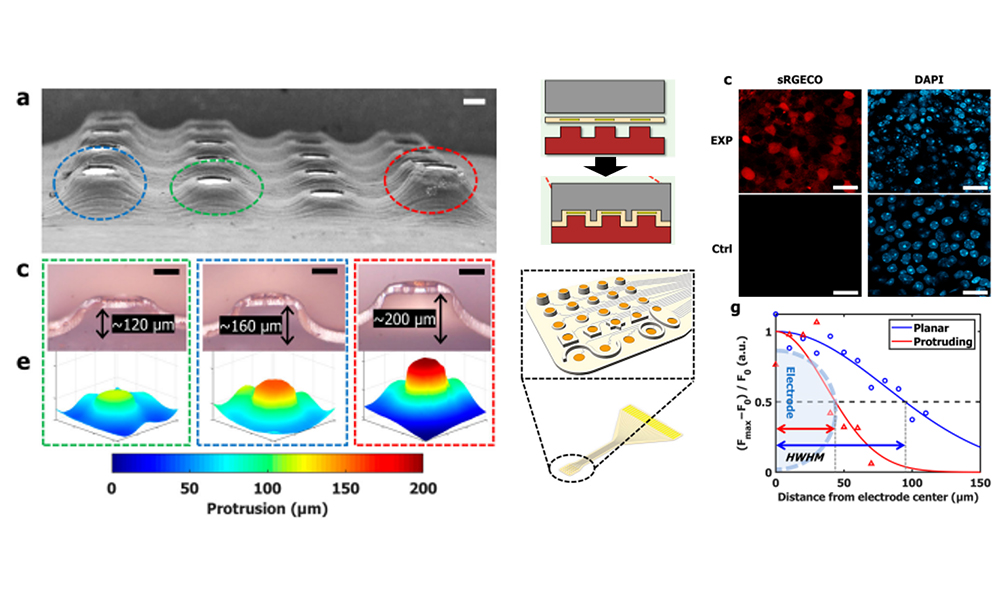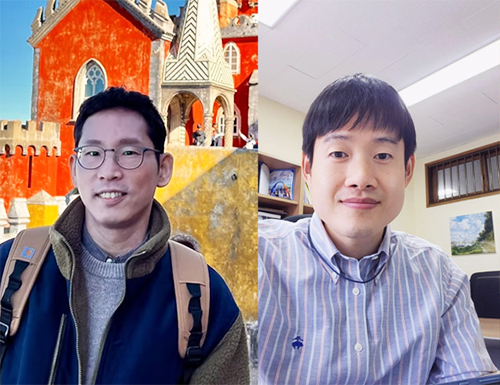
PNU 리서치
- 메인으로 이동
- 연구/산학
- PNU 리서치

의생명융합공학부 정준수 교수와 전기전자공학부 엄경식 교수 연구팀은 ‘미세전자열성형(μETF)’이라는 혁신적인 방법으로 미세한 3차원 구조를 갖춘 유연한 신경 인터페이스를 제작해 뇌-컴퓨터 접속장치나 인공망막 장치의 신경 기록 및 자극 성능을 향상시키는 데 성공했다.
연구팀은 플라스틱 필름을 일회용 컵, 뚜껑 등 다양한 형태로 가공하는 열성형기술에서 영감을 얻어, 신경계를 효율적으로 기록·자극하기 위한 미세 3차원 구조의 유연성 신경접속장치를 제작하기 위한 ‘미세전자열성형(μETF: Microelectrothermoforming)’ 기술을 세계 최초로 개발했다.
뇌, 척수, 망막 등 복잡한 형태의 신경조직에 맞춤 제작된 미세전자소자로 신경자극의 효율성과 정밀도를 높임으로써 뇌-컴퓨터 접속장치, 인공망막장치 등 다양한 뇌신경공학기술의 발전에 획기적 돌파구가 될 것으로 기대된다.
신경계와 접속해 신경신호를 기록하거나 자극해 다양한 질병과 장애를 치료하기 위한 신경공학기술에서는 생체전자소자와 신경세포의 밀접한 접촉이 매우 중요하다. 기존의 신경접속장치는 일반적으로 평면 구조를 가지고 있어 다양한 형태의 신경 조직에 밀착하는 데 한계가 있었으며, 3D 구조를 제작하기 위해서는 공정이 복잡해지고 디자인 형태가 제한되는 한계가 있었다.
이러한 한계를 극복하기 위해 연구팀은 플라스틱 필름을 식품용기, 포장재 등 다양한 형태로 성형하는 플라스틱 열성형(thermoforming)에서 착안해, 이를 미세한 구조의 유연전자소자에 적용해 3차원 구조를 손쉽게 만들 수 있는 미세전자열성형(μETF: Microelectrothermoforming) 기술을 구현했다.
미세전자열성형 기술은 미세 전극이 내장된 얇고 유연한 폴리머 필름을 가열한 후 3D 프린팅된 몰드에 압착하는 방식으로 이뤄진다. 이 공정을 통해 정밀한 돌출 및 함몰 구조를 형성해 전극이 목표 신경에 보다 가깝게 배치되도록 하면서도 전기적 특성을 유지할 수 있다. 기존 미세 가공 방식과 달리, μETF는 공정을 단순화하면서도 복잡한 3D 구조를 단일 MEA 내에서 구현할 수 있다.


【왼쪽부터 교신저자 정준수 교수와 엄경식 교수, 제1저자 이동현 박사와 박영훈 박사과정생】
연구팀은 망막 자극을 최적화한 3D 전극을 개발해 시각장애인을 위한 인공망막장치 적용 가능성을 탐색했다. 컴퓨터 시뮬레이션과 망막 실험 결과, 3D 전극은 기존 평면 전극 대비 자극 임계값을 1.7배 낮추고 공간 해상도를 2.2배 향상시키는 것으로 나타났다. 엄경식 교수는 “우리의 3D 구조는 전극을 목표 신경에 더욱 가깝게 배치해 자극의 효율성과 정밀도를 높인다”고 소개했다.
연구팀은 이 기술이 뇌, 척수, 달팽이관(와우), 말초신경을 포함한 다양한 신경 인터페이스에 적용될 수 있을 것으로 기대하고 있다. 정준수 교수는 “이 기술은 형태의 제약 없이 다양한 미세 3D 구조의 신경접속장치를 제작할 수 있어, 신경조직 특성 맞춤형 신경접속장치 설계가 가능하다”고 강조했다.
개발 기술의 가장 유망한 응용 분야 중 하나는 뇌-컴퓨터 인터페이스(BCI)다. BCI는 마비 환자의 움직임을 복원하는 데 활용될 수 있으며, 3D 신경 전극 어레이를 운동 피질에 이식하면 신경 신호를 해독해 로봇 팔이나 휠체어를 제어하는 등의 물리적 동작으로 변환할 수 있다. 연구팀은 웨어러블 전자 기기, 오가노이드 연구, 랩온어칩(Lab-on-a-Chip) 시스템 등 다양한 분야에서 이 기술이 적용될 가능성을 탐색하고 있다.
해당 기술은 신경 기록 및 자극을 향상시키면서도 제조 공정을 단순화할 수 있다는 점에서 신경공학 기술과 신경 재활 치료의 획기적인 발전을 이끌 것으로 전망된다.
이번 연구는 과학기술정보통신부 우수신진연구 및 기초연구실 지원사업을 통해 의생명융합공학부 정준수 교수와 전기전자공학부 엄경식 교수가 교신저자, 기계공학부 이동현 박사와 전기전자공학부 박영훈 박사과정생이 제1저자로 수행했다.
연구 결과는 JCR 1.8% 최상위 국제 학술지인 『npj Flexible Electronics』 온라인 1월 22일자에 게재됐다.
- 논문 제목: Microelectrothermoforming (μETF): one-step versatile 3D shaping of flexible microelectronics for enhanced neural interfaces(미세전자열성형 기술을 통한 고성능 3차원 신경접속장치)
- 논문 링크: https://www.nature.com/articles/s41528-024-00378-0
- DOI: 10.1038/s41528-024-00378-0
* 상단 연구 이미지: 미세전자열성형 기술을 통해 제작된 3차원 구조의 미세 신경접속장치 및 쥐 망막 실험을 통해 자극 효율성과 정밀도의 향상을 검증.
[Abstract]
Neural interfaces are crucial in restoring and enhancing impaired neural functions, but current technologies struggle to achieve close contact with soft and curved neural tissues. Researchers at Pusan National University have introduced an innovative method—microelectrothermoforming (μETF)—to create flexible neural interfaces with microscopic three-dimensional (3D) structures. Their findings show how this method improves neural recording and stimulation, with potential applications in artificial retina devices and brain-computer interfaces.
The μETF method involves heating a thin, flexible polymer sheet embedded with microelectrodes and pressing it against a 3D-printed mold. The researchers used liquid crystal polymer (LCP) as the substrate due to its mechanical strength, biocompatibility, and long-term stability. This process forms precise protruding and recessed structures, enhancing the electrode's proximity to target neurons while preserving its electrical properties. Unlike traditional micromachining approaches, μETF simplifies fabrication and allows for a wide range of complex 3D structures, including wells, domes, walls, and triangular features, all within a single MEA.
The versatility of μETF extends beyond neural interfaces. The research team is exploring its potential in wearable electronics, organoid studies, and lab-on-a-chip systems, where precise 3D microstructures could enhance device functionality. The next step includes refining fabrication techniques for broader medical applications.
With its ability to enhance neural recording and stimulation while simplifying fabrication, μETF represents a major advancement in neuroprosthetic technology and neural rehabilitation treatments.
- Authors (Pusan National University)
· First authors: Dong Hyeon Lee (School of Mechanical Engineering), Younghoon Park (Department of Electronics Engineering)
· Corresponding authors: Kyungsik Eom (Department of Electronics Engineering), Joonsoo Jeong (Department of Information Convergence Engineering)
- Title of original paper: Microelectrothermoforming (μETF): one-step versatile 3D shaping of flexible microelectronics for enhanced neural interfaces
- Journal: npj Flexible Electronics
- Web link: https://www.nature.com/articles/s41528-024-00378-0
- Contact e-mail: joonsoo_jeong@pusan.ac.kr, kseom@pusan.ac.kr
